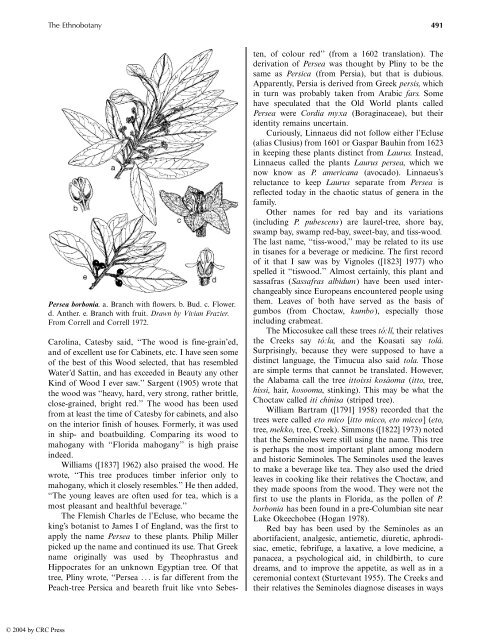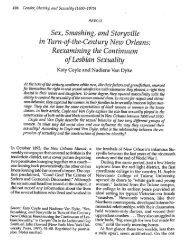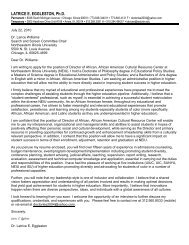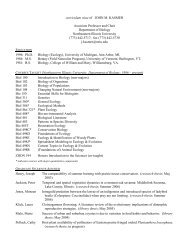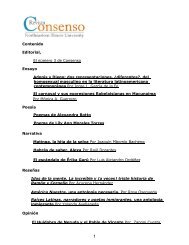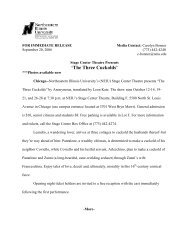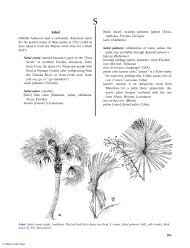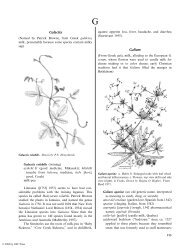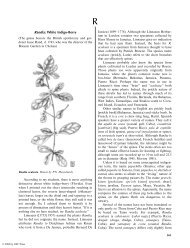Herba Cana - Northeastern Illinois University
Herba Cana - Northeastern Illinois University
Herba Cana - Northeastern Illinois University
Create successful ePaper yourself
Turn your PDF publications into a flip-book with our unique Google optimized e-Paper software.
© 2004 by CRC Press<br />
The Ethnobotany 491<br />
Persea borbonia. a. Branch with flowers. b. Bud. c. Flower.<br />
d. Anther. e. Branch with fruit. Drawn by Vivian Frazier.<br />
From Correll and Correll 1972.<br />
Carolina, Catesby said, ‘‘The wood is fine-grain’ed,<br />
and of excellent use for Cabinets, etc. I have seen some<br />
of the best of this Wood selected, that has resembled<br />
Water’d Sattin, and has exceeded in Beauty any other<br />
Kind of Wood I ever saw.’’ Sargent (1905) wrote that<br />
the wood was ‘‘heavy, hard, very strong, rather brittle,<br />
close-grained, bright red.’’ The wood has been used<br />
from at least the time of Catesby for cabinets, and also<br />
on the interior finish of houses. Formerly, it was used<br />
in ship- and boatbuilding. Comparing its wood to<br />
mahogany with ‘‘Florida mahogany’’ is high praise<br />
indeed.<br />
Williams ([1837] 1962) also praised the wood. He<br />
wrote, ‘‘This tree produces timber inferior only to<br />
mahogany, which it closely resembles.’’ He then added,<br />
‘‘The young leaves are often used for tea, which is a<br />
most pleasant and healthful beverage.’’<br />
The Flemish Charles de l’Ecluse, who became the<br />
king’s botanist to James I of England, was the first to<br />
apply the name Persea to these plants. Philip Miller<br />
picked up the name and continued its use. That Greek<br />
name originally was used by Theophrastus and<br />
Hippocrates for an unknown Egyptian tree. Of that<br />
tree, Pliny wrote, ‘‘Persea ... is far different from the<br />
Peach-tree Persica and beareth fruit like vnto Sebes-<br />
ten, of colour red’’ (from a 1602 translation). The<br />
derivation of Persea was thought by Pliny to be the<br />
same as Persica (from Persia), but that is dubious.<br />
Apparently, Persia is derived from Greek persis, which<br />
in turn was probably taken from Arabic fars. Some<br />
have speculated that the Old World plants called<br />
Persea were Cordia myxa (Boraginaceae), but their<br />
identity remains uncertain.<br />
Curiously, Linnaeus did not follow either l’Ecluse<br />
(alias Clusius) from 1601 or Gaspar Bauhin from 1623<br />
in keeping these plants distinct from Laurus. Instead,<br />
Linnaeus called the plants Laurus persea, which we<br />
now know as P. americana (avocado). Linnaeus’s<br />
reluctance to keep Laurus separate from Persea is<br />
reflected today in the chaotic status of genera in the<br />
family.<br />
Other names for red bay and its variations<br />
(including P. pubescens) are laurel-tree, shore bay,<br />
swamp bay, swamp red-bay, sweet-bay, and tiss-wood.<br />
The last name, ‘‘tiss-wood,’’ may be related to its use<br />
in tisanes for a beverage or medicine. The first record<br />
of it that I saw was by Vignoles ([1823] 1977) who<br />
spelled it ‘‘tiswood.’’ Almost certainly, this plant and<br />
sassafras (Sassafras albidum) have been used interchangeably<br />
since Europeans encountered people using<br />
them. Leaves of both have served as the basis of<br />
gumbos (from Choctaw, kumbo), especially those<br />
including crabmeat.<br />
The Miccosukee call these trees tó:lî, their relatives<br />
the Creeks say tó:la, and the Koasati say tolá.<br />
Surprisingly, because they were supposed to have a<br />
distinct language, the Timucua also said tola. Those<br />
are simple terms that cannot be translated. However,<br />
the Alabama call the tree ittoissi kosáoma (itto, tree,<br />
hissi, hair, kosooma, stinking). This may be what the<br />
Choctaw called iti chinisa (striped tree).<br />
William Bartram ([1791] 1958) recorded that the<br />
trees were called eto mico [itto micco, eto micco] (eto,<br />
tree, mekko, tree, Creek). Simmons ([1822] 1973) noted<br />
that the Seminoles were still using the name. This tree<br />
is perhaps the most important plant among modern<br />
and historic Seminoles. The Seminoles used the leaves<br />
to make a beverage like tea. They also used the dried<br />
leaves in cooking like their relatives the Choctaw, and<br />
they made spoons from the wood. They were not the<br />
first to use the plants in Florida, as the pollen of P.<br />
borbonia has been found in a pre-Columbian site near<br />
Lake Okeechobee (Hogan 1978).<br />
Red bay has been used by the Seminoles as an<br />
abortifacient, analgesic, antiemetic, diuretic, aphrodisiac,<br />
emetic, febrifuge, a laxative, a love medicine, a<br />
panacea, a psychological aid, in childbirth, to cure<br />
dreams, and to improve the appetite, as well as in a<br />
ceremonial context (Sturtevant 1955). The Creeks and<br />
their relatives the Seminoles diagnose diseases in ways


